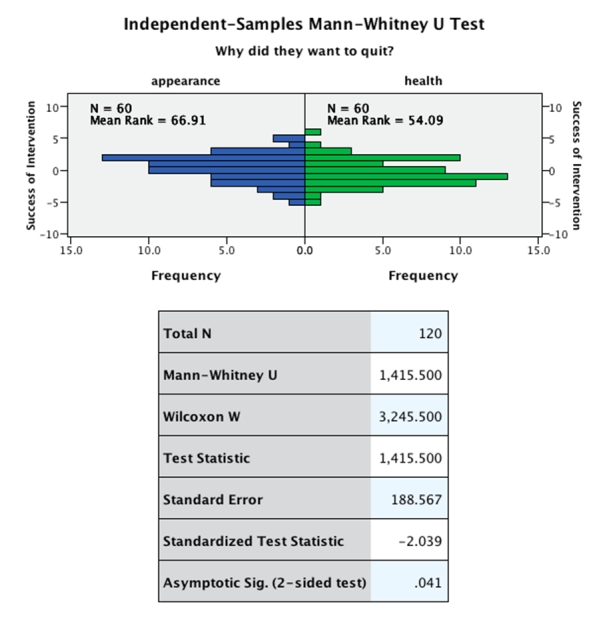Imagine we wanted to investigate whether the reason for quitting smoking affects success rate.We recruited a sample of 120 smokers.Half wanted to quit to improve their appearance (yellow teeth and bad breath,etc.) ,and half wanted to quit to improve their health (life expectancy,etc.) .After six months we measured how successful they had been at quitting smoking.The data were skewed so we ran a Wilcoxon rank-sum test on the data (output below) . Which of the following sentences correctly reports the results from the Wilcoxon rank-sum test? 
A) People who wanted to quit smoking to improve their health were significantly more successful at quitting than those who wanted to quit to improve their appearance,Ws = 3245.5,z = -2.04,p = .04.
B) People who wanted to quit smoking to improve their appearance were significantly more successful at quitting than those who wanted to quit to improve their health,T = -2.04,z = 188.57,p < .05.
C) This output relates to the Mann-Whitney test and tells us nothing about the Wilcoxon rank-sum test.
D) People who wanted to quit smoking to improve their appearance were significantly more successful at quitting than those who wanted to quit to improve their health,Ws = 3245.5,z = -2.04,p = .04.
Correct Answer:
Verified
Q1: When the groups have unequal numbers of
Q2: Which of the following non-parametric tests does
Q6: Which of the following tests would you
Q7: What symbol represents the test statistic for
Q10: A researcher measured people's physiological reactions to
Q13: Imagine we wanted to investigate whether the
Q14: A researcher measured people's physiological reactions while
Q15: The _ and _ tests are calculated
Q16: What is the non-parametric equivalent of the
Q21: When the groups have equal numbers of
Unlock this Answer For Free Now!
View this answer and more for free by performing one of the following actions

Scan the QR code to install the App and get 2 free unlocks

Unlock quizzes for free by uploading documents